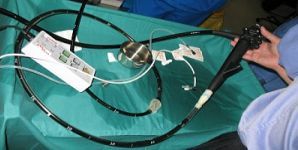Data on Double Balloon Enteroscopy Shows it is Safe and Effective
The endosopic procedure double balloon enteroscopy (DBE) has been shown to be safe and effective for detection of diseases of the small intestine.

The endosopic procedure double balloon enteroscopy (DBE) has been shown to be safe and effective for detection of diseases of the small intestine, according to a large-scale survey of data from the last 10 years published in a recent issue of GIE: Gastrointestinal Endoscopy.
DBE had a pooled detection rate of 68.1% for all small intestinal disease; suspected mid-gastrointestinal bleeding was found to be the most common indication, with a relatively high detection rate. Inflammatory lesions and vascular lesions were the most common findings in patients with suspected mid-gastrointestinal bleeding, according to a statement released by the American Society for Gastrointestinal Endoscopy.
“We finally have composite large-scale data to support what we have suspected—DBE performed in appropriately selected individuals is a highly useful and extremely safe clinical tools that can be used for a variety of indications for deep endoscopy,” Andrew S. Ross, MD, Digestive Diseases Institute at the Virginia Mason Medical Center in Seattle, wrote in an accompanying editorial.
“Although it is clearly an improvement over technologies of the past, DBE is not without its limitations and does not provide an answer in every patient. … In the case of small-bowel disorders and obscure GI bleeding in particular, it is up to us as endoscopists to selectively choose from the now-myriad selection of devices within our toolbox that can help us to solve what is often a vexing clinical problem.”
Although there have been many published articles addressing the technical aspects and positive findings of DBE, most were of small sample size and show inconsistent, if not controversial, data among different settings and in different countries.
The researchers performed a systematic review of all eligible studies related to diagnostic DBE to produce state-of-the-art data on indications, lesion detection rate, total enteroscopy, and complications in examining diseases of the small intestine.
The researchers, led by Zhuan Liao, MD, and Zhao-Shen Li, MD, of Changhai Hospital, Second Military Medical University, Shanghai, China, searched PubMed between January 2001 and March 2010 for original articles about DBE evaluation of diseases of the small intestine. Data on the total number of procedures, distribution of indications, pooled detection rate, pooled total enteroscopy rate, and composition of positive findings were extracted and/or calculated. In addition, the data involving DBE-associated complications were analyzed.
The researchers’ analysis was based on 66 articles in English that involved 12,823 procedures. Suspected mid-gastrointestinal bleeding was the most common indication (62.5%), followed by symptoms and signs only (7.9%), small intestine obstruction (5.8%), and Crohn’s disease (5.8%). The pooled detection rates were as follows: suspected mid-gastrointestinal bleeding (68.1%), symptoms and signs only (68%), Crohn’s disease (53.6%), and small intestine obstruction (63.4%). The overall detection rate was 85.8%. The researchers found that DBE is a valuable modality, with a pooled detection rate of 68.1% for all small intestinal disease.
SourceStudy Examining Large-Scale Data of Double Balloon Enteroscopy Shows it is Safe and Effective [American Society for Gastrointestinal Endoscopy]